Wing morphometrics as a tool in species identification of forensically important blow flies of Thailand
- PMID: 28486970
- PMCID: PMC5424331
- DOI: 10.1186/s13071-017-2163-z
Wing morphometrics as a tool in species identification of forensically important blow flies of Thailand
Abstract
Background: Correct species identification of blow flies is a crucial step for understanding their biology, which can be used not only for designing fly control programs, but also to determine the minimum time since death. Identification techniques are usually based on morphological and molecular characters. However, the use of classical morphology requires experienced entomologists for correct identification; while molecular techniques rely on a sound laboratory expertise and remain ambiguous for certain taxa. Landmark-based geometric morphometric analysis of insect wings has been extensively applied in species identification. However, few wing morphometric analyses of blow fly species have been published.
Methods: We applied a landmark-based geometric morphometric analysis of wings for species identification of 12 medically and forensically important blow fly species of Thailand. Nineteen landmarks of each right wing of 372 specimens were digitised. Variation in wing size and wing shape was analysed and evaluated for allometric effects. The latter confirmed the influence of size on the shape differences between species and sexes. Wing shape variation among genera and species were analysed using canonical variates analysis followed by a cross-validation test.
Results: Wing size was not suitable for species discrimination, whereas wing shape can be a useful tool to separate taxa on both, genus and species level depending on the analysed taxa. It appeared to be highly reliable, especially for classifying Chrysomya species, but less robust for a species discrimination in the genera Lucilia and Hemipyrellia. Allometry did not affect species separation but had an impact on sexual shape dimorphism.
Conclusions: A landmark-based geometric morphometric analysis of wings is a useful additional method for species discrimination. It is a simple, reliable and inexpensive method, but it can be time-consuming locating the landmarks for a large scale study and requires non-damaged wings for analysis.
Keywords: Blow fly; Forensic entomology; Species identification; Thailand; Wing morphometry.
Figures
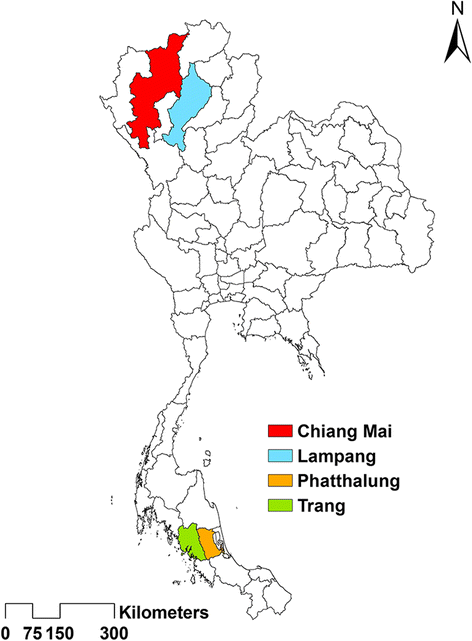

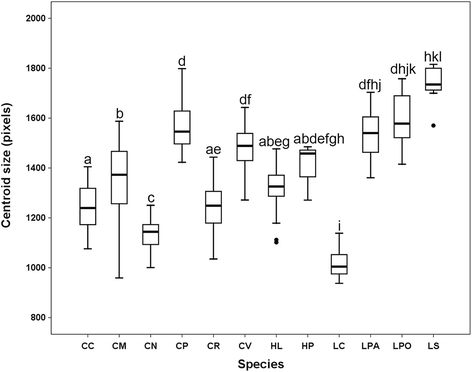
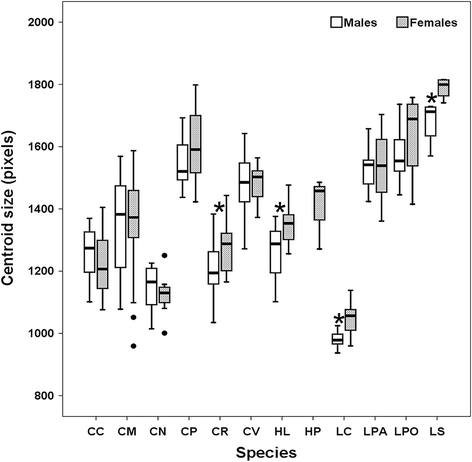
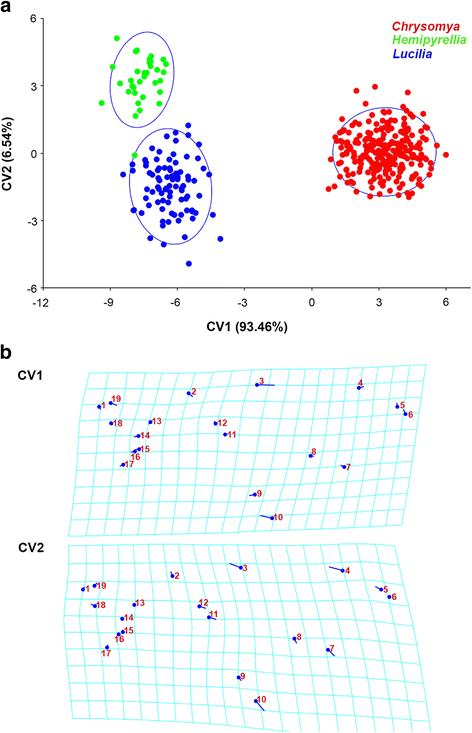
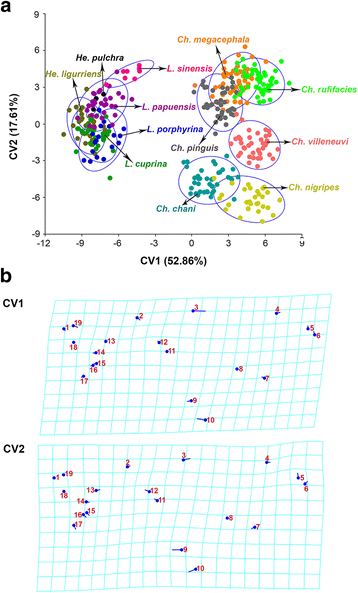
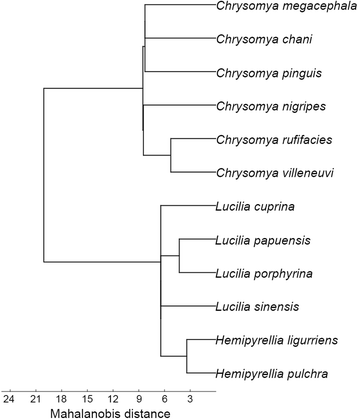
Similar articles
-
Wing morphometric analysis of forensically important flesh flies (Diptera: Sarcophagidae) in Thailand.Acta Trop. 2019 Feb;190:312-319. doi: 10.1016/j.actatropica.2018.12.011. Epub 2018 Dec 7. Acta Trop. 2019. PMID: 30529446
-
Wing morphometrics of medically and forensically important muscid flies (Diptera: Muscidae).Acta Trop. 2021 Oct;222:106062. doi: 10.1016/j.actatropica.2021.106062. Epub 2021 Jul 18. Acta Trop. 2021. PMID: 34289390
-
Wing measurement can be used to identify European blow flies (Diptera: Calliphoridae) of forensic importance.Forensic Sci Int. 2019 Mar;296:1-8. doi: 10.1016/j.forsciint.2019.01.001. Epub 2019 Jan 6. Forensic Sci Int. 2019. PMID: 30639998
-
Forensic entomology cases in Thailand: a review of cases from 2000 to 2006.Parasitol Res. 2007 Oct;101(5):1417-23. doi: 10.1007/s00436-007-0659-8. Epub 2007 Jul 24. Parasitol Res. 2007. PMID: 17647017 Review.
-
Geometric morphometrics in mosquitoes: What has been measured?Infect Genet Evol. 2017 Oct;54:205-215. doi: 10.1016/j.meegid.2017.06.029. Epub 2017 Jun 30. Infect Genet Evol. 2017. PMID: 28673547 Review.
Cited by
-
Geometric Morphometrics and Genetic Diversity Analysis of Chalcidoidea (Diglyphus and Pachyneuron) at Various Elevations.Insects. 2024 Jul 3;15(7):497. doi: 10.3390/insects15070497. Insects. 2024. PMID: 39057230 Free PMC article.
-
Molecular and morphometric divergence of four species of butterflies (Nymphalidae and Pieridae) from the Western Himalaya, India.Mol Biol Rep. 2020 Nov;47(11):8687-8699. doi: 10.1007/s11033-020-05913-6. Epub 2020 Oct 18. Mol Biol Rep. 2020. PMID: 33070284
-
Intraspecific variation in wing geometry among Tabanus rubidus (Diptera: Tabanidae) populations in Thailand.Front Vet Sci. 2022 Sep 2;9:920755. doi: 10.3389/fvets.2022.920755. eCollection 2022. Front Vet Sci. 2022. PMID: 36118331 Free PMC article.
-
Geometric morphometric wing analysis as a tool to discriminate female mosquitoes from different suburban areas of Chiang Mai province, Thailand.PLoS One. 2021 Nov 29;16(11):e0260333. doi: 10.1371/journal.pone.0260333. eCollection 2021. PLoS One. 2021. PMID: 34843516 Free PMC article.
-
Real-Time Detection and Classification of Scirtothrips dorsalis on Fruit Crops with Smartphone-Based Deep Learning System: Preliminary Results.Insects. 2023 Jun 5;14(6):523. doi: 10.3390/insects14060523. Insects. 2023. PMID: 37367339 Free PMC article.
References
-
- Greenberg B. Flies and disease: ecology, classification and biotic associations. New Jersey: Princeton University Press; 1971.
-
- Srivoramas T, Chaiwong T, Sanford MR. Isolation of fungi from adult house fly; Musca domestica and the blow fly Chrysomya megacephala in Ubon Ratchathani province, northeastern Thailand. Int J Parasitol Res. 2012;4:53–56. doi: 10.9735/0975-3702.4.1.53-56. - DOI
-
- Zumpt F. Myiasis in man and animals in the old world. London: Butterworths; 1965.
MeSH terms
LinkOut - more resources
Full Text Sources
Other Literature Sources

